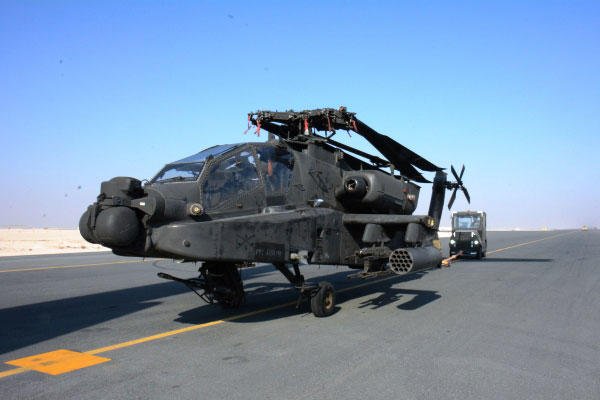The U.S. increasingly dominates the global arms trade, with agreements totaling about $36 billion last year -- more than half of the worldwide market, according to a new congressional report.
In the Dec. 21 document, researchers at the Congressional Research Service, which provides nonpartisan policy analysis for members of Congress, concluded the U.S. ranked first in the overall sales last year, followed by Russia.
"In worldwide arms transfer agreements in 2014 -- to both developed and developing nations -- United States dominated, ranking first with $36.2 billion in such agreements or 50.4% of all such agreements," the report states. "Russia ranked second in worldwide arms transfer agreements in 2014 with $10.2 billion in such global agreements or 14.2%. The value of all arms transfer agreements worldwide in 2014 was $71.8 billion."
What's more, the U.S. share of overall sales increased to 50 percent in 2014 from 38 percent in 2013, according to the report.
The transactions included a $9.6 billion sale to Qatar for Patriot PAC-3 missiles made by Lockheed Martin Corp., Javelin missiles made by Lockheed and Raytheon Co. and AH-64 Apache attack helicopters made by Boeing Co.; a $7 billion-plus order from South Korea for CH-47D Chinook cargo helicopters, RQ-4 Global Hawk surveillance drone made by Northrop Grumman Corp. and other equipment; a $4 billion deal to supply Saudi Arabia with TOW missiles made by Raytheon and other weapons; among others.
Like others published by the research organization, the document was written for lawmakers and wasn't publicly released. But it was obtained and subsequently shared by watchdogs, including Steven Aftergood, director of the government secrecy project at the Federation of American Scientists, a Washington, D.C.-based nonprofit that publishes scientific analysis to protect against national-security threats.
The figure for overall sales represented a slight increase -- about $1.7 billion, or 2 percent -- from the previous year, the report states. The market is flat in part because of the financial crisis in Europe and slow international recovery from the 2008 global recession -- factors that have "limited defense purchases" by prospective customers, it states.
The vast majority of the weapon transfer agreements -- about $62 billion, or 86 percent -- went to developing countries such as South Korea, Iraq, Brazil, Saudi Arabia and Qatar, according to the document. The report focuses on developing countries because of the level of market activity in these regions, where "the potential for the outbreak of regional military conflicts currently is greatest," it states.
The Cold War-era practice of governments arming allies with advanced weaponry in an attempt to minimize military disadvantages continues, with Russia, in particular, and China supplying partner countries with thousands of surface-to-air missiles and other systems, according to the report.
China has delivered battlefield and cruise missiles to Iran and surface-to-surface missiles to Pakistan, it states. And Russia has supplied more than 9,400 SAMs to developing countries in the four-year period through 2014 -- up from about 7,300 in the four-year period ending 2010, it states.
Russia plans to sell three or four of the S-300 surface-to-air missile systems to Iran in coming months for an unspecified price. Iran has long wanted to buy the S-300, which carries the NATO reporting name SA-10 Grumble and is designed to provide defensive cover from enemy aircraft and cruise missiles.
U.S. generals have warned that Russia's development of new surface-to-air missile systems and other air defenses has "closed the gap" between U.S. air superiority, a general said.
The country in recent years has deployed an increasing number of higher quality air defense systems, particularly in and around Kaliningrad and Crimea -- which it annexed from the Ukraine in 2014 -- to limit the ability of U.S. and NATO aircraft to enter its airspace, Air Force Gen. Frank Gorenc, the service's European commander has said.
"I don't think it's controversial to say that they've closed the gap in capability -- not just in Europe, everywhere," he said in September in Washington, D.C., at the Air and Space Conference organized by the Air Force Association.
Gorenc didn't cite specific systems, but the Russians have multiple surface-to-air missiles systems designed to target high-altitude aircraft, from the S-400, arguably the most advanced such system in the world, to the S-75A Dvina, which in 1960 was employed to shoot down an American-made U-2 spy plane as it traveled over Soviet airspace.
Indeed, Russia's Buk missile system, which has the NATO designations SA-11/SA-17, was what pro-Russian separatists reportedly fired at Malaysia Airlines Flight 17 on July 17, 2014, while the plane was traveling near the Russian-Ukraine border, destroying the aircraft and killing all 298 passengers and crew on board.
--Brendan McGarry can be reached at brendan.mcgarry@military.com. Follow him on Twitter at @Brendan_McGarry.




























